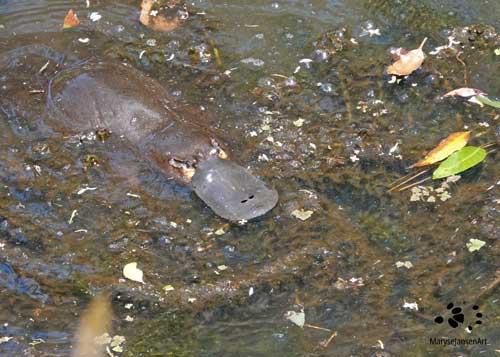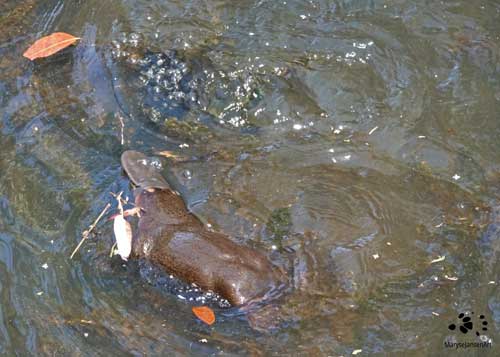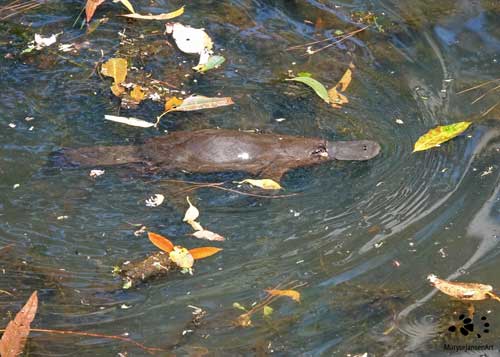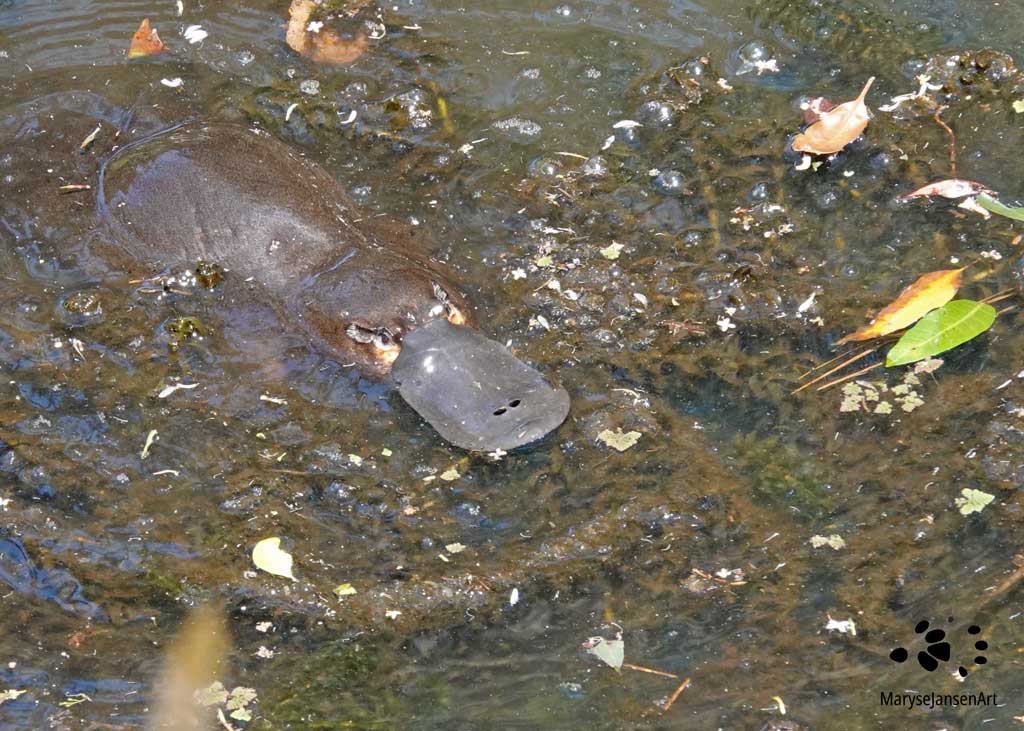Wildlife Photography with marysejansenart
Rarely seen up close in broad daylight!

Table of Contents
To see a platypus ‘You’ve gotta get lucky!’
My steps take me in the direction of the platypus viewing platform. I know my chances of seeing a platypus are not high, it’s way too late in the day, it’s too hot and sunny and on top of that it’s too noisy as well! But … I’m here now, I might as well have a look.
Platypus are usually seen at dusk or dawn, possibly during the day when it’s overcast or raining and not too hot. Platypus are generally very shy creatures as well, and the slightest noise or movement will cause them to stay out of sight. As you can read here in my earlier post about this amazing creature, this really has been my experience.
I look out over the water. I see a couple of turtles, Water Dragons and lots of dragonflies and butterflies. It is quite a lively scene and worth coming out for, even when I don’t see a platypus. (Read more about a good ‘wildlife spotting mindset’ here!)
A lady comes in with her dog, she’s a local and has seen the platypus here before. It’s not in sight now. “You’ve gotta get lucky”, she says. After a few minutes she leaves again.
Against all odds
Then a family comes in and we chat a bit. Suddenly I notice some of those characteristic circular ripples on the water’s surface. They come from just behind the bend, where we can’t really see the animal. I’m holding my breath, but I reckon there is too much noise with all the chatter from these people.
I can’t believe my eyes when the animal suddenly appears in view. That is just amazing! Wow! It seems to be completely oblivious with regards to all the ‘platypus viewing rules’! Undisturbed by our presence, the heat and the bright sunlight, it is happily on the hunt.
Diving and feeding
On average a dive takes about 30 – 60 seconds, after which the platypus will surface for about 20 seconds or less. The platypus can stay under for longer periods of time as well. It can swim underwater for up to two and a half minutes. When in danger it may find a hiding place under water, stay really still and drop its heart rate. This allows it to stay under for up to 11 minutes before it needs to come up for a breath again. After every dive my eyes are eagerly scanning the water to see where it comes up again.

During a dive, the platypus hunts for aquatic invertebrates. It’s favourite snack are insect larvae. It can also take creatures such as shrimps, water bugs, tadpoles and swimming beetles. When under water it closes its eyes, ears and nostrils and relies entirely on its bill to find prey. The bill is very sensitive to pressure and has electro-receptors. ‘In this murky water its eyes wouldn’t be of much use anyway’, I’m thinking. Prey is stored in the cheek pouches and chewed when the platypus comes up to the surface.
On a feeding trip a platypus may travel a fair distance. One kilometre is common, but they may go as far as 7 kilometres! As it disappears around the next bend, I don’t know if I will still be here when it comes back. But I decide to stay put for a while and enjoy the other wildlife there. Luckily I did as it does indeed return about half an hour later!
Getting close-up
It gets better and better when the animal decides to come even closer to where I’m standing and I can get a really good look at it! Check it out in the featured image! In the bright daylight this is the ideal opportunity to film and photograph this amazing and unique animal and marvel at its appearance.
After a while the animal disappears around the bend again, from where I first noticed the ripples on the water’s surface. I suppose its burrow is somewhere there. When done feeding, a platypus will retract into its burrow and snuggle up for a long sleep.
The burrow is dug in the bank of the river, lake or stream. The entrance is about 10-15cm wide. Usually it is above the water’s surface but it may also be just below. Inside the burrow chamber it is always dry though, so that the platypus can breathe while resting and sleeping.

Breeding Habits
The platypus is a solitary animal and it is highly territorial. It is possible to see several animals close together though, when feeding grounds are rich. In breeding season the males search their territory to find a female to mate with. After a brief courtship and the act of mating, they become solitary again. The female lays one or two eggs in her burrow. She curls up around the eggs, using her tail and belly to keep them warm during the incubation period which takes 10-11 days.
When the little puggles are born, they are only 1.5cm long. The mother nurses them with her milk for the first 4-5 months. When she leaves the burrow to hunt, she closes the entrance with loose soil. The youngsters stay in the burrow until they are about 6 months old. They are then ready to become independent really quickly. A platypus in the wild can live 7-14 years.
Join me at the viewing platform to see the amazing close up footage of the foraging platypus, as well as some of the other creatures it shares its habitat with.
If you are interested in purchasing a print of the featured image ‘Platypus Portrait‘ or would like to see what the image looks like on the various merchandise products, please head to my shop. If you prefer ‘Platypus Swirl‘, click here and for ‘Platypus‘, click here.


